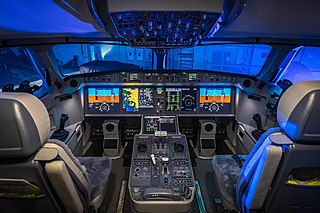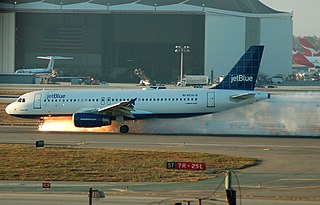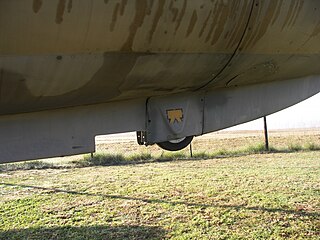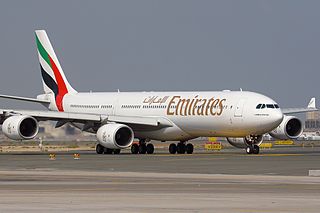
The Airbus A330 is a wide-body aircraft developed and produced by Airbus. Airbus began developing larger A300 derivatives in the mid-1970s, giving rise to the A330 twinjet as well as the A340 quadjet, and launched both designs alongside with their first orders in June 1987. The A330-300, the first variant, took its maiden flight in November 1992 and entered service with Air Inter in January 1994. The slightly shorter A330-200 variant followed in 1998 with Canada 3000 as the launch operator.
Air Algérie SpA is the flag carrier of Algeria, with its head office in the Immeuble El-Djazair in Algiers. With flights operating from Houari Boumedienne Airport, Air Algérie operates scheduled international services to 39 destinations in 28 countries in Europe, North America, Africa, Asia, and the Middle East, as well as domestic services to 32 airports. As of December 2013, Air Algérie was 100% owned by the Government of Algeria.

A glass cockpit is an aircraft cockpit that features an array of electronic (digital) flight instrument displays, typically large LCD screens, rather than traditional analog dials and gauges. While a traditional cockpit relies on numerous mechanical gauges to display information, a glass cockpit uses several multi-function displays driven by flight management systems, that can be adjusted to display flight information as needed. This simplifies aircraft operation and navigation and allows pilots to focus only on the most pertinent information. They are also popular with airline companies as they usually eliminate the need for a flight engineer, saving costs. In recent years the technology has also become widely available in small aircraft.

Wake turbulence is a disturbance in the atmosphere that forms behind an aircraft as it passes through the air. It includes several components, the most significant of which are wingtip vortices and jet-wash, the rapidly moving gases expelled from a jet engine.
A deadstick landing, also called a dead-stick landing, is a type of forced landing when an aircraft loses all of its propulsive power and is forced to land. The "stick" does not refer to the flight controls, which in most aircraft are either fully or partially functional without engine power, but to the traditional wooden propeller, which without power would just be a "dead stick". When a pilot makes an emergency landing of an aircraft that has some or all of its propulsive power still available, the procedure is known as a precautionary landing.

An emergency landing is a premature landing made by an aircraft in response to an emergency involving an imminent or ongoing threat to the safety and operation of the aircraft, or involving a sudden need for a passenger or crew on board to terminate the flight. It typically involves a forced diversion to the nearest or most suitable airport or airbase, or an off airport landing or ditching if the flight cannot reach an airfield. Flights under air traffic control will be given priority over all other aircraft operations upon the declaration of the emergency.

Pilot error generally refers to an accident in which an action or decision made by the pilot was the cause or a contributing factor that led to the accident, but also includes the pilot's failure to make a correct decision or take proper action. Errors are intentional actions that fail to achieve their intended outcomes. The Chicago Convention defines the term "accident" as "an occurrence associated with the operation of an aircraft [...] in which [...] a person is fatally or seriously injured [...] except when the injuries are [...] inflicted by other persons." Hence the definition of "pilot error" does not include deliberate crashing.

In aviation, a tailstrike or tail strike occurs when the tail or empennage of an aircraft strikes the ground or other stationary object. This can happen with a fixed-wing aircraft with tricycle undercarriage, in both takeoff where the pilot rotates the nose up too rapidly, or in landing where the pilot raises the nose too sharply during final approach, often in attempting to land too near the runway threshold. It can also happen during helicopter operations close to the ground, when the tail inadvertently strikes an obstacle.

Armavia Flight 967 was a scheduled international passenger flight operated by Armavia from Zvartnots International Airport, Zvarnots in Armenia to Sochi, a Black Sea coastal resort city in Russia. On 3 May 2006, the aircraft operating the route, an Airbus A320-200, crashed into the sea while attempting a go-around following its first approach to Sochi airport; all 113 aboard were killed. The accident was the first major commercial airline crash in 2006. It was Armavia's only fatal crash during the airline's existence.
The article describes accidents and incidents on Korean Air and its predecessor companies Korean National Airlines and Korean Air Lines.
An Air Data Inertial Reference Unit (ADIRU) is a key component of the integrated Air Data Inertial Reference System (ADIRS), which supplies air data and inertial reference information to the pilots' electronic flight instrument system displays as well as other systems on the aircraft such as the engines, autopilot, aircraft flight control system and landing gear systems. An ADIRU acts as a single, fault tolerant source of navigational data for both pilots of an aircraft. It may be complemented by a secondary attitude air data reference unit (SAARU), as in the Boeing 777 design.

China Airlines Flight 605 was a daily non-stop flight departing from Taipei at 6:30 a.m. and arriving at Kai Tak Airport in Hong Kong at 7:00 a.m. local time. On November 4, 1993, the plane went off the runway and overran while landing during a storm. It was the first hull loss of a Boeing 747-400.

Qantas Flight 72 (QF72) was a scheduled flight from Singapore Changi Airport to Perth Airport by an Airbus A330. On 7 October 2008, the flight made an emergency landing at Learmonth Airport near the town of Exmouth, Western Australia, following an inflight accident that included a pair of sudden, uncommanded pitch-down manoeuvres that caused severe injuries—including fractures, lacerations and spinal injuries—to several of the passengers and crew. At Learmonth, the plane was met by the Royal Flying Doctor Service of Australia and CareFlight. Fourteen people were airlifted to Perth for hospitalisation, with 39 others also attending hospital. In all, one crew member and 11 passengers suffered serious injuries, while eight crew and 99 passengers suffered minor injuries. The Australian Transport Safety Bureau (ATSB) investigation found a fault with one of the aircraft's three air data inertial reference units (ADIRUs) and a previously unknown software design limitation of the Airbus A330's fly-by-wire flight control primary computer (FCPC).
This is a list of aviation-related events from 2009.

Emirates Flight 407 was a scheduled international passenger flight operated by Emirates from Auckland to Dubai with a stopover in Melbourne, operated by an Airbus A340-500 aircraft. On 20 March 2009, the flight failed to take off properly at Melbourne Airport, hitting several structures at the end of the runway before climbing and then returning to the airport for a safe landing. Although no fatalities or injuries resulted, damage to the aircraft was severe enough for the event to be classified by Australian Transport Safety Bureau as an "accident". It was subsequently determined that a data-entry error resulted in insufficient engine thrust during take off. It has been described "as close as we have ever come to a major aviation catastrophe in Australia" by aviation officials.
Air France has been in operation since 1933. Its aircraft have been involved in a number of major accidents and incidents. The deadliest accident of the airline occurred on June 1, 2009, when Air France Flight 447, an Airbus A330-203, flying from Rio de Janeiro to Paris crashed into the Atlantic Ocean with 228 fatalities. A selected list of the most noteworthy of these events is given below.

Cathay Pacific Flight 780 was a flight from Juanda International Airport in Surabaya, Indonesia, to Hong Kong International Airport on 13 April 2010. On board were 309 passengers and a crew of 13. As Flight 780 neared Hong Kong, the crew were unable to change the thrust output of the engines. The aircraft, an Airbus A330-300, landed at almost twice the speed of a normal landing, suffering minor damage. The 57 passengers who sustained injuries were hurt in the ensuing slide evacuation; one of them received serious injuries.

Air Canada Flight 624 was a scheduled Canadian domestic passenger flight from Toronto Pearson International Airport to Halifax Stanfield International Airport in Halifax, Nova Scotia. During heavy snow and poor visibility, at 00:43 ADT on 29 March 2015, the Airbus A320-211 landed short of the runway and was severely damaged. Twenty-six people were injured.












